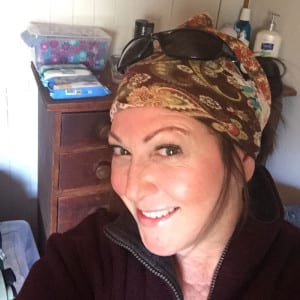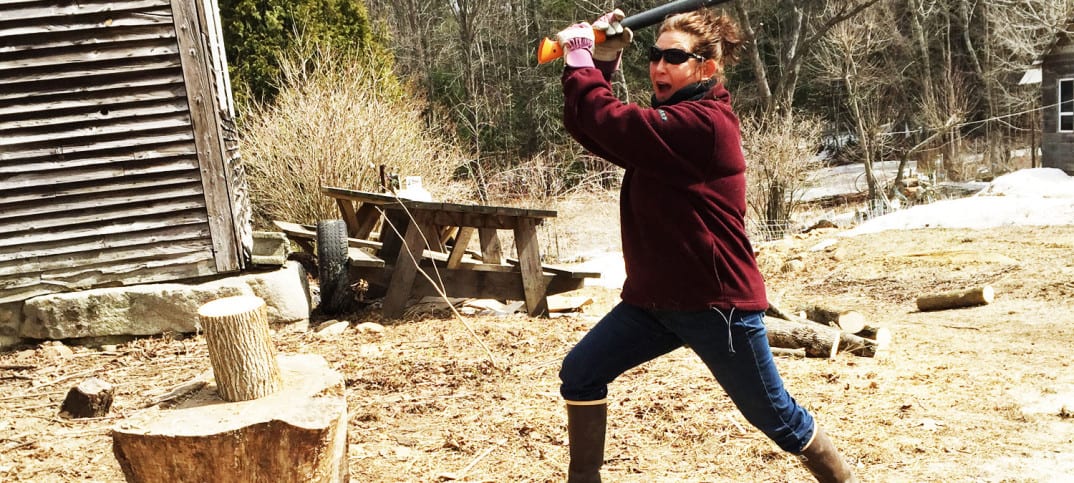By Stacy Santini
This is the second in a four-part series. Miss the first installment? Read it here.
Once my decision and logistics were finalized, the preparing began and believe me, this was no easy feat for a woman who had spent most of her life tucked into neatly landscaped neighborhoods and luxury vehicles that had never seen a dirt road. It is mandatory to have the right clothing, gear and provisions for this type of living. In retrospect, I know that it would have been impossible for me to have survived mud season in New England without my neoprene muck boots, North Face rain attire and Cabela’s thermals. With every item of clothing I packed, varying weather conditions were always a factor, and my Jeep Patriot became the keeper of six large suitcases and numerous plastic bins; my vehicle overflowing with my expectations and a little fear, well, maybe a whole lot of fear. I also had a little Morkie, Charles Crawford, to consider, and he had his own impedimenta.
I selected two farms to call home during my time as a WWOOFer, and they could not have been more different. My first agrarian family was the Owens. Ruth and Derek were an elderly couple running a well-established 180 acre farm, Owen Farm, in Hopkinton, New Hampshire, for more than forty years. The property included 30 acres of cleared land primarily used for pasture, a small orchard and 1 acre for planting and gardening. When I pulled up to their large colonial farmhouse on April 1st at 4 p.m., there was still snow on the ground, chickens running amuck and the property was buzzing with activity. I was greeted by fellow WWOOFers, a young Southern California couple named Camille and Gregg, who had arrived two weeks earlier, and as Gregg swooshed past me carrying a pile of wood, I became acutely aware that I was indeed doing this; I was about to become a farmer.
Adjustment is an understatement to describe my first few days at Owen Farm. Dignity took a back seat as I slowly but surely acquired humility and a work ethic not often seen by the rest of society. At this time of year, while most of the ground was still frozen, our main duties involved caring for the animals, which included cows which are milked by hand, sheep, pigs, poultry and horses, three of which were Arabian.

My first introduction to animal farming was the very afternoon I arrived when I observed Camille feeding Hallelujah, the resident pig who was the size of a small freight train, a “sumptuous” bucket of composting leftover veggies. At 5 a.m. the next morning, I had the pleasure of meeting Karl, the alpha cow. As she entered the barn for the first of her two daily milkings, I was overwhelmed with the enormity of this mammal. Our daily chores began before sunrise and would include gathering eggs at the chicken coop several times a day, feeding the cows and sheep, wheelbarrowing hay out to pasture for the horses and mucking stalls. When these obligations were filled, we would have special projects, like building fences and uprooting the 4 feet of manure and bedding in the sheep shelter.
The ground was frozen solid in the awakening sunrise hours but would melt somewhat by afternoon. Our footing was constantly challenged during our chores and it was not uncommon to be walking and soon find out that one of our appendages was wearing just a sock as the last step had stolen our boot which was being suctioned into the mud.
Our work on the farm monopolized most of our waking moments. Our main relief from these enjoyable but arduous tasks was mealtime. We ate family style three times a day and everyone would gather in the farmhouse kitchen at the big oak table. Missing a meal was frowned upon, as Ruth, the revered matriarch of this homestead, would spend the majority of her time at her century-old black wood-burning stove cooking creations from what was available from the farm and cupboard or reinventing leftover dinner from the night before. We feasted on stews, farm-raised pork, fresh greens and topped it all off with homemade dressings and cheese.
The word “waste” was not part of our lives or vernacular at Owen Farm. Every scrap, every egg shell, every bone was utilized, whether turned into compost or recycled, and we were very aware of the ramifications of squandering. After lunch, we would take an hour or so before returning outdoors to learn about wet felting, knitting and how to make condiments such as butter.
Ruth and Derek Owen were two of the most beautiful, stoic individuals to cross my path. I learned much from them and was grateful for the rare moments Ruth would take on the role of nurturing Mother. I started to look forward to Derek’s dry, humorous one liners with relief, as much as I welcomed his worn overalls as they would approach me, knowing I was having difficulty with a task. But their lifestyle is in such stark comparison to what I am used to that adapting was one of my greatest challenges.
Having little running water, only a compost toilet and very little time for hygiene, I struggled to let go of routines that are so much a part of my daily existence. Blow dryers, make-up and freshly washed towels did not exist during my stay. The Owens consider those things frivolous, unnecessary, and I must admit, as much as I missed my creature comforts, there was a certain freedom in letting all that go.
Dwelling under these conditions is not for the faint of heart and as I did my damnedest to acclimate, Charles Crawford, who was now being referred to as Farmer Chuck, was fighting his own battles . . .
Like what you’ve read? Check out part three here.
Stacy Santini is a freelance reporter for Times Beacon Record Newspapers. Look for her adventures at Owen Farm in Hopkinton, New Hampshire, and Patch Farm in Denmark, Maine, in the next two issues of Arts & Lifestyles.







